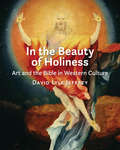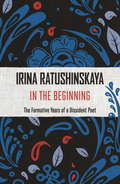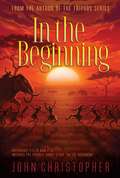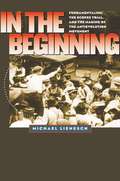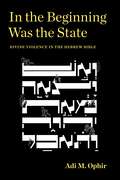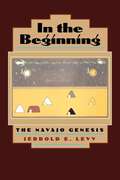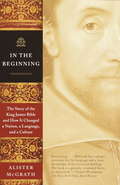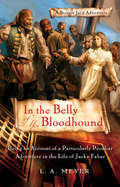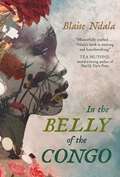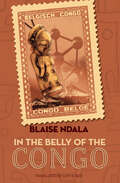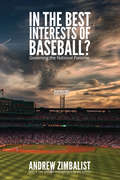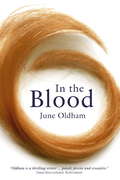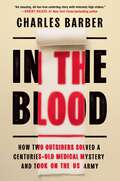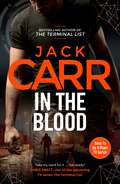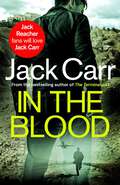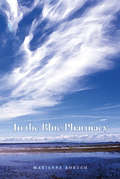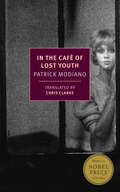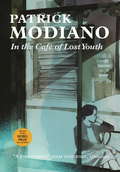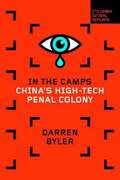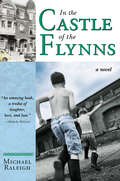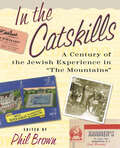- Table View
- List View
In the Beauty of Holiness: Art and the Bible in Western Culture
by David Lyle JeffreyThe Academy of Parish Clergy&’s 2018 Top Five Reference Books for Parish Ministry Beauty and holiness are both highly significant subjects in the Bible. In this comprehensive study of Christian fine art David Lyle Jeffrey explores the relationship between beauty and holiness as he integrates aesthetic perspectives from the ancient Hebrew Scriptures through Augustine, Aquinas, and Kant down to contemporary philosophers of art. From the walls of the Roman catacombs to the paintings of Marc Chagall, visual art in the West has consistently drawn its most profound and generative inspiration from biblical narrative and imagery. Jeffrey guides readers through this artistic tradition from the second century to the twenty-first, astutely pointing out its relationship not only to the biblical sources but also to related expressions in liturgy and historical theology. Lavishly illustrated throughout with 146 masterworks, reproduced in full color, In the Beauty of Holiness is ideally suited to students of Christian fine art, to devotees of biblical studies, and to general readers wanting to better understand the story of Christian art through the centuries.
In the Beauty of Holiness: Art and the Bible in Western Culture
by David Lyle JeffreyThe Academy of Parish Clergy&’s 2018 Top Five Reference Books for Parish Ministry Beauty and holiness are both highly significant subjects in the Bible. In this comprehensive study of Christian fine art David Lyle Jeffrey explores the relationship between beauty and holiness as he integrates aesthetic perspectives from the ancient Hebrew Scriptures through Augustine, Aquinas, and Kant down to contemporary philosophers of art. From the walls of the Roman catacombs to the paintings of Marc Chagall, visual art in the West has consistently drawn its most profound and generative inspiration from biblical narrative and imagery. Jeffrey guides readers through this artistic tradition from the second century to the twenty-first, astutely pointing out its relationship not only to the biblical sources but also to related expressions in liturgy and historical theology. Lavishly illustrated throughout with 146 masterworks, reproduced in full color, In the Beauty of Holiness is ideally suited to students of Christian fine art, to devotees of biblical studies, and to general readers wanting to better understand the story of Christian art through the centuries.
In the Beginning
by Irina RatushinskayaIN THE BEGINNING goes back to the poet's life before her arrest, interweaving her experiences of growing up in Odessa with those of her childhood friend and future husband Igor Geraschenko. With wit and simplicity Irina describes a biased and turbulent education, being pressured to work for the KGB, the growth of faith that became so important to her in later life, and an impromptu wedding. Ratushinskaya shows how her early experiences moulded her personality, enabling her at a time of almost unbearable pressure to remain true to her own convictions.
In the Beginning
by John ChristopherLove proves ancient as time itself in this prehistoric adventure romance from critically acclaimed Tripods author John Christopher.In the beginning, many, many years ago, there were two tribes. Dom was a boy from the hunting tribe, and Va was a girl from the farming tribe. The two tribes fought, but that couldn't stop Dom and Va from falling in love.In the midst of battle, Dom escapes and takes Va with him. Together, they journey across the stark landscape of eons past, learning about the harsh and aggressive world around them even as they learn more about the creative and peaceful feelings within themselves.In the Beginning includes the prequel short story "In the Beginning" and the novel Dom and Va, and marks a captivating departure from John Christopher's other, futuristic work: this is a tale of the distant past, and of a beginning that represents the conflicts inherent in human nature--and the dark and light in all of us.
In the Beginning
by Michael LieneschThe current controversy over teaching evolution in the public schools has grabbed front-page headlines and topped news broadcasts all across the United States. In the Beginning investigates the movement that has ignited debate in state legislatures and at school board meetings. Reaching back to the origins of antievolutionism in the 1920s, and continuing to the promotion of intelligent design today, Michael Lienesch skillfully analyzes one of the most formidable political movements of the twentieth century. Applying extensive original sources and social movement theory, Lienesch begins with fundamentalism, describing how early twentieth-century fundamentalists worked to form a collective identity, to develop their own institutions, and to turn evolution from an idea into an issue. He traces the emerging antievolution movement through the 1920s, examining debates over Darwinism that took place on college campuses and in state legislatures throughout the country. With fresh insights and analysis, Lienesch retells the story of the 1925 Scopes "monkey" trial and reinterprets its meaning. In tracking the movement from that time to today, he explores the rise of creation science in the 1960s, the alliance with the New Christian Right in the 1980s, and the development of the theory of intelligent design in our own time. He concludes by speculating on its place in the politics of the twenty-first century. In the Beginning is essential for understanding the past, present, and future debates over the teaching of evolution.Reaching back to the origins of antievolutionism in the 1920s, and continuing to the promotion of intelligent design today, Michael Lienesch skillfully analyzes the creationism movement, one of the most formidable political movements of the twentieth century. With fresh insights, Lienesch retells the story of the 1925 Scopes "monkey" trial and reinterprets its meaning. In tracking the movement from that time to today, he explores the rise of creation science in the 1960s, the alliance with the New Christian Right in the 1980s, and the development of the theory of intelligent design in our own time. He concludes by speculating on its place in the politics of the twenty-first century.-->
In the Beginning Was the State: Divine Violence in the Hebrew Bible (Idiom: Inventing Writing Theory)
by Adi M. OphirThis book explores God’s use of violence as depicted in the Hebrew Bible. Focusing on the Pentateuch, it reads biblical narratives and codes of law as documenting formations of theopolitical imagination. Ophir deciphers the logic of divine rule that these documents betray, with a special attention to the place of violence within it. The book draws from contemporary biblical scholarship, while also engaging critically with contemporary political theory and political theology, including the work of Walter Benjamin, Giorgio Agamben, Jan Assmann, Regina Schwartz, and Michael Walzer.Ophir focuses on three distinct theocratic formations: the rule of disaster, where catastrophes are used as means of governance; the biopolitical rule of the holy, where divine violence is spatially demarcated and personally targeted; and the rule of law where divine violence is vividly remembered and its return is projected, anticipated, and yet postponed, creating a prolonged lull for the text’s present.Different as these formations are, Ophir shows how they share an urform that anticipates the main outlines of the modern European state, which has monopolized the entire globe. A critique of the modern state, the book argues, must begin in revisiting the deification of the state, unpacking its mostly repressed theological dimension.
In the Beginning: A Short History of the Hebrew Language
by Joel HoffmanDecodes the long history of Hebrew and its influential place as the ancestor of many modern written languagesHebrew as a language is just over 3,000 years old, and the story of its alphabet is unique among the languages of the world. Hebrew set the stage for almost every modern alphabet, and was arguably the first written language simple enough for everyone, not just scribes, to learn, making it possible to make a written record available to the masses for the first time. Written language has existed for so many years—since around 3500 BCE—that most of us take it for granted. But as Hoffman reveals in this entertaining and informative work, even the idea that speech can be divided into units called “words” and that these words can be represented with marks on a page, had to be discovered. As Hoffman points out, almost every modern system of writing descends from Hebrew; by studying the history of this language, we can learn a good deal about how we express ourselves today.Hoffman follows and decodes the adventure that is the history of Hebrew, illuminating how the written record has survived, the significance of the Dead Sea Scrolls and ancient translations, and attempts to determine how the language actually sounded. He places these developments into a historical context, and shows their continuing impact on the modern world.This sweeping history traces Hebrew's development as one of the first languages to make use of vowels. Hoffman also covers the dramatic story of the rebirth of Hebrew as a modern, spoken language.Packed with lively information about language and linguistics and history, In the Beginning is essential reading for both newcomers and scholars interested in learning more about Hebrew and languages in general.
In the Beginning: The Navajo Genesis
by Jerrold E. LevyJerrold E. Levy's masterly analysis of Navajo creation and origin myths shows what other interpretations often overlook: that the Navajo religion is as complete and nuanced an attempt to answer humanity's big questions as the religions brought to North America by Europeans. Looking first at the historical context of the Navajo narratives, Levy points out that Navajo society has never during its known history been either homogeneous or unchanging, and he goes on to identify in the myths persisting traditions that represent differing points of view within the society. The major transformations of the Navajo people, from a northern hunting and gathering society to a farming, then herding, then wage-earning society in the American Southwest, were accompanied by changes not only in social organization but also in religion. Levy sees evidence of internal historical conflicts in the varying versions of the creation myth and their reflection in the origin myths associated with healing rituals. Levy also compares Navajo answers to the perennial questions about the creation of the cosmos and why people are the way they are with the answers provided by Judaism and Christianity. And, without suggesting that they are equivalent, Levy discusses certain parallels between Navajo religious ideas and contemporary scientific cosmology. The possibility that in the future Navajo religion will be as much altered by changing conditions as it has been in the past makes this fascinating account all the more timely.
In the Beginning: The Story of the King James Bible and How It Changed a Nation, a Language, and a Culture
by Alister McGrathThis fascinating history of a literary and religious masterpiece explores the forces that obstructed and ultimately led to the decision to create an authorized translation, the method of translation and printing, and the central role the King James version of the Bible played in the development of modern English. In the sixteenth century, to attempt to translate the Bible into a common tongue wasn't just difficult, it was dangerous. A Bible in English threatened the power of the monarch and the Church. Early translators like Tyndale, whose work greatly influenced the King James, were hunted down and executed, but the demand for English Bibles continued to grow. Indeed it was the popularity of the Geneva Bible, with its anti-royalist content, that eventually forced James I to sanction his own, pro-monarchy, translation. Errors in early editions--one declared that "thou shalt commit adultery"--and Puritan preferences for the Geneva Bible initially hampered acceptance of the King James, but it went on to become the definitive English-language Bible. McGrath's history of the King James Bible&’s creation and influence is a worthy tribute to a great work and a joy to read.
In the Belly of the Bloodhound
by Louis A. MeyerThe British crown has placed a price on Jacky's head, so she returns to the Lawson Peabody School for Young Girls in Boston to lay low. But the safe haven doesn't last--a school outing goes awry as Jacky and her classmates are abducted and forced into the hold of the Bloodhound, a ship bound for the slave markets on the Barbary Coast. All of Jacky's ingenuity, determination, and plain old good luck will be put to the test as she rallies her delicate classmates to fight together and become their own rescuers.
In the Belly of the Congo
by Blaise NdalaA sweeping historical novel and an intergenerational family saga about the mysterious disappearance of a Congolese princess and the niece who is determined to uncover her fate more than four decades later, by the internationally acclaimed and award-winning Congolese Canadian author Blaise Ndala.April 1958. Princess Tshala Nyota, daughter of King Kena Kwete III of the Kuba people in Congo, is among the eleven &“villagers&” put on display at the 1958 World&’s Fair in Brussels. After the humiliation of the Nazi occupation, the royal palace is determined to restore the Belgian colonial empire&’s honor and prestige by showcasing the successful &“civilization&” of Congo, Belgium&’s &“model colony,&” at one of the biggest international events since the end of the Second World War. The young princess recounts her journey from her home of Kasaï to a Catholic school run by nuns, where she meets and falls madly in love with a handsome Belgian administrator. But when her father discovers the affair, his fury cannot be contained. Fearing for her life and his own, Tshala&’s lover sends her to Léopoldville to stay with his friend, a collector and dealer specializing in African art. In the capital, she is immersed in a world pulsing with youth, sex, energy, and hope for the new independent republic. But when Tshala is betrayed by her lover&’s friend, she is sent to Brussels and her forced exhibition at Expo &’58. Soon after, she mysteriously disappears. August 2003. Nyota Kwete, the princess&’s niece, is sent to Brussels to continue her education at the university. Before she departs, her father charges her with the task of discovering the fate of the missing princess. In Brussels, she is welcomed by the Congolese diaspora community and crosses paths with a Belgian scholar who is haunted by his own ghosts. Together, they uncover important secrets that were taken to the grave. In this internationally acclaimed and award-winning novel, Congolese Canadian author Blaise Ndala examines Belgium and Congo&’s colonial past and current legacy through the lives of two unforgettable women, connected by family and history across continents and decades.
In the Belly of the Congo: A Novel
by Blaise NdalaA gripping multigenerational novel that explores the history and human cost of colonialism in the Congo.April 1958. Organizing the Brussels World&’s Fair, the biggest international event since the end of the Second World War, subcommissioner Robert Dumont cedes to pressure from the royal palace: there will be a &“Congolese village&” in one of the seven pavilions devoted to the settlements. Among the eleven members of this &“human zoo&” assembled to put on a show at the foot of the Atomium is the young Tshala, daughter of the intractable king of the Bakuba. From her native Kasai to Brussels via Léopoldville, the princess&’s journey unfolds—until her forced exhibition at Expo 58, where we lose track of her. Summer 2004. Newly arrived in Belgium, a niece of the missing princess crosses paths with a man haunted by the ghost of his father—Francis Dumont, professor of law at the Free University of Brussels. A breathtaking series of events will reveal to them a secret the former subcommissioner of Expo 58 carried to his grave. From one century to the next, In the Belly of the Congo confronts History with a capital &“H&” to pose the central question of the colonial equation: Can the past pass?
In the Best Interests of Baseball?: Governing the National Pastime
by Andrew ZimbalistIn the Best Interests of Baseball? is a thoughtful, balanced look at the impact of the ninth commissioner of baseball, Bud Selig, on the sport as well as an examination of the commissioner’s position in a historical context. The more controversial topics Andrew Zimbalist probes include the conflicts of interest arising from Selig’s original role as owner/commissioner; Selig’s response to the persistent steroids scandal; the commissioner’s role in promoting and marketing the sport; player relations and the collective-bargaining agreement; managing explosive conflicts among the owners; the game’s economic challenges; major changes made on Selig’s watch; and Selig’s growing compensation. Underlying this very public evaluation is a far more challenging question: given the legal, economic, and political architecture of Major League Baseball, can any commissioner act in the best interest of the game? Based on dozens of interviews with Selig, former president and chief operating officer of Major League Baseball Bob DuPuy, and scores of baseball insiders and interested outsiders, as well as on mountains of historic baseball documents, In the Best Interests of Baseball? challenges everything you thought you knew about the game, the Major Leagues, the players, the owners, and, most of all, the man at the helm. This edition includes a new preface and epilogue by the author discussing the developments in the baseball industry since 2005 and anticipating what lies ahead for the national pastime.
In the Blood
by June OldhamRigby's grandfather, Gilbert, has wandered from home and is roaming the Yorkshire countryside in distress. Finding an old map in his grandfather's home, peculiarly annotated and marked by his grandfather, Rigby begins to realise that it duplicates Normandy: the marked sites mirror places in another place and other time - the days following the Normandy landings in 1944. He is drawn down an elusive trail into the past, hunting old memories and new truths to the heart of his grandfather's youth in the raw days of the War. It shakes the very foundations of Rigby's own young life, and as he discovers the secret about another soldier - the quest becomes an inner journey for Rigby. He learns of the feelings of young men caught in the terrors and misery of the battlefield, and the impact of their lives on generations to come.
In the Blood: How Two Outsiders Solved a Centuries-Old Medical Mystery and Took On the US Army
by Charles BarberThe "high-stakes" true story of how an absent-minded inventor and a down-on-his-luck salesman joined forces to create a once‑in‑a‑generation lifesaving product: "Suspenseful storytelling helps us see and feel the struggle and frustration, the sweat and tears . . . Inspiring&” (Robert Kolker, #1 New York Times bestselling author of Hidden Valley Road). At the 1993 Battle of Mogadishu, dramatized by the popular film Black Hawk Down, the majority of soldiers who died were killed instantly or bled to death before they could reach an operating table. This tragedy reinforced the need for a revolutionary treatment that could transform trauma medicine. So, when Frank Hursey and Bart Gullong—who had no medical or military experience—discovered that a cheap, crushed rock called zeolite had blood‑clotting properties, they brought it to the military's attention. The Marines and the Navy adopted the resulting product, QuikClot, immediately. The Army, however, resisted. It had two products of its own being developed to prevent excessive bleeds, one of which had already cost tens of millions of dollars. The other, "Factor Seven," had a more dangerous complication: its side effects could be deadly. Unwilling to let its efforts end in failure—and led by the highly influential surgeon Colonel John Holcomb—the Army set out to smear QuikClot&’s reputation. Over the course of six years, Hursey and Gullong engaged in an epic struggle with Holcomb for recognition. Ultimately, a whistle‑blower inside the Army challenged the Army&’s embrace of Factor Seven, which resulted in a massive lawsuit led by the U.S. Department of Justice. The lawsuit focused further attention on the financial ties between the pharmaceutical company that produced Factor Seven and Holcomb&’s research institute. By withholding QuikClot—which later became the medical miracle of the Iraq War—and in the use of Factor Seven with its known, life-threatening risks of heart attacks and strokes, the lives of countless soldiers were imperiled. Using deep reportage and riveting prose, In the Blood recounts this little‑known David‑and‑Goliath story of corruption, greed, and power within the military—and the devastating consequences of unchecked institutional arrogance.
In the Blood: James Reece 5 (Terminal List Ser. #5)
by Jack Carr**NOW AN AMAZON PRIME TV SERIES STARRING CHRIS PRATT**'Take my word for it, James Reece is one rowdy motherf***er. Get ready!' CHRIS PRATT A woman boards a plan in Burkina Faso having just completed a targeted assassination for the state of Israel. Two minutes after takeoff her plane is blown out of the sky. 6000 miles to the east, James Reece watches the names and pictures of the victims cross cable news. One face triggers a distant memory of a Mossad operative attached to the CIA years earlier in Iraq, a woman with ties to the intelligence services of two nations, a woman Reece thought he would never see again… In a global pursuit spanning four continents, James Reece will enlist the help of friends new and old to track down her killer and walk right into a trap set by a master sniper, a sniper who has enlisted help of his own…The 5th in the bestselling James Reece series, from former Navy SEAL Jack Carr. If you loved Lee Child's Jack Reacher, Peter James's Roy Grace or Michael Connelly's Mickey Haller, you will love James Reece! Praise for Jack Carr: &‘A propulsive and compulsive series. Jack Carr&’s James Reece is the kind of guy you&’d want to have in your corner. A suspenseful and exhilarating thrill-ride. Jack Carr is the real deal&’ Andy McNab 'This is seriously good . . . the suspense is unrelenting, and the tradecraft is so authentic the government will probably ban it – so read it while you can!' Lee Child 'With a particular line in authentic tradecraft, this fabulously unrelenting thrill-ride was a struggle to put down' Mark Dawson 'Gritty, raw and brilliant!' Tom Marcus &‘So powerful, so pulse-pounding, so well-written – rarely do you read a debut novel this damn good&’ Brad Thor 'Carr writes both from the gut and a seemingly infinite reservoir of knowledge in the methods of human combat. Loved it!' Chris Hauty 'A powerful, thoughtful, realistic, at times terrifying thriller that I could not put down. A terrific addition to the genre, Jack Carr and his alter-ego protagonist, James Reece, continue to blow me away' Mark Greaney 'Thrilling' Publishers Weekly
In the Blood: James Reece 5 (Terminal List Ser. #5)
by Jack Carr**NOW AN AMAZON PRIME TV SERIES STARRING CHRIS PRATT**'Take my word for it, James Reece is one rowdy motherf***er. Get ready!' CHRIS PRATT A woman boards a plan in Burkina Faso having just completed a targeted assassination for the state of Israel. Two minutes after takeoff her plane is blown out of the sky. 6000 miles to the east, James Reece watches the names and pictures of the victims cross cable news. One face triggers a distant memory of a Mossad operative attached to the CIA years earlier in Iraq, a woman with ties to the intelligence services of two nations, a woman Reece thought he would never see again… In a global pursuit spanning four continents, James Reece will enlist the help of friends new and old to track down her killer and walk right into a trap set by a master sniper, a sniper who has enlisted help of his own…The 5th in the bestselling James Reece series, from former Navy SEAL Jack Carr. If you loved Lee Child's Jack Reacher, Peter James's Roy Grace or Michael Connelly's Mickey Haller, you will love James Reece! Praise for Jack Carr: &‘A propulsive and compulsive series. Jack Carr&’s James Reece is the kind of guy you&’d want to have in your corner. A suspenseful and exhilarating thrill-ride. Jack Carr is the real deal&’ Andy McNab 'This is seriously good . . . the suspense is unrelenting, and the tradecraft is so authentic the government will probably ban it – so read it while you can!' Lee Child 'With a particular line in authentic tradecraft, this fabulously unrelenting thrill-ride was a struggle to put down' Mark Dawson 'Gritty, raw and brilliant!' Tom Marcus &‘So powerful, so pulse-pounding, so well-written – rarely do you read a debut novel this damn good&’ Brad Thor 'Carr writes both from the gut and a seemingly infinite reservoir of knowledge in the methods of human combat. Loved it!' Chris Hauty 'A powerful, thoughtful, realistic, at times terrifying thriller that I could not put down. A terrific addition to the genre, Jack Carr and his alter-ego protagonist, James Reece, continue to blow me away' Mark Greaney 'Thrilling' Publishers Weekly
In the Blue Pharmacy
by Marianne BoruchCollected here are sixteen essays on poets and poetry, the writing life, and a host of fascinating topics that come into the wide range of Marianne Boruch's attention. She examines how the imagination works with mystery and surprise in a variety of poets from Elizabeth Bishop to Theodore Roethke, from Russell Edson to Larry Levis, from Walt Whitman to Eavan Boland. Combining a richly associative personal style with original insights on poetic texts and historical and cultural musing, Boruch considers how the atomic bomb changed William Carlos Williams's deepest ambition for poetry, and how Edison's listening, through his famous deafness, informs our sense of the poetic line. Other essays explore how the car-its danger and solitude-helps us understand American poetry or how Dvorak and Whitman shared darker things than their curious love for trains. Poetry transforms, changing over time in the work of individual poets as well as changing us as we read it or write it.Boruch's writing has a musical, incantatory style, creating a mood in which many of her subjects are immersed. Her approach isn't meant to fix or crystallize her ideas in any hard and fast light, but rather to present the music of her thinking.
In the Blue Pharmacy
by Marianne BoruchCollected here are sixteen essays on poets and poetry, the writing life, and a host of fascinating topics that come into the wide range of Marianne Boruch's attention. She examines how the imagination works with mystery and surprise in a variety of poets from Elizabeth Bishop to Theodore Roethke, from Russell Edson to Larry Levis, from Walt Whitman to Eavan Boland. Combining a richly associative personal style with original insights on poetic texts and historical and cultural musing, Boruch considers how the atomic bomb changed William Carlos Williams's deepest ambition for poetry, and how Edison's listening, through his famous deafness, informs our sense of the poetic line. Other essays explore how the car-its danger and solitude-helps us understand American poetry or how Dvorak and Whitman shared darker things than their curious love for trains. Poetry transforms, changing over time in the work of individual poets as well as changing us as we read it or write it.Boruch's writing has a musical, incantatory style, creating a mood in which many of her subjects are immersed. Her approach isn't meant to fix or crystallize her ideas in any hard and fast light, but rather to present the music of her thinking.
In the Café of Lost Youth
by Patrick Modiano Chris ClarkeWho was Louki? Did anyone really know? She made her mark on all of us in different ways. We all remember her, some of us more than others, but did any of us truly know her? Can anyone honestly say they know another person? In the Café of Lost Youth is vintage Patrick Modiano, an absorbing evocation of a particular Paris of the 1950s, shadowy and shady, a secret world of writers, criminals, drinkers, and drifters. The novel, which includes vignettes of a number of historical figures and is inspired in part by the circle (depicted in the photographs of Ed van der Elsken) of the notorious and charismatic Guy Debord, centers on the enigmatic, waiflike figure of Louki, who catches everyone's attention even as she eludes possession or comprehension. Through the eyes of four very different narrators, we contemplate Louki's character and her fate, while Modiano explores the themes of identity, memory, time, and forgetting that are at the heart of his hypnotic and deeply moving art.
In the Café of Lost Youth
by Patrick ModianoFour narrators, a student from a café, a private detective hired by an aggrieved husband, the heroine herself and one of her lovers, construct a portrait of Jacqueline Delanque, otherwise known as Louki. The daughter of a single mother who works in the Moulin Rouge, Louki grows up in poverty in Montmartre. Her one attempt to escape her background fails when she is rejected from the Lycée Jules-Ferry. She meanders on through life, into a cocaine habit, and begins frequenting the Café Condé, whose regulars call her "Louki". She drifts into marriage with a real estate agency director, but finds no satisfaction with him or his friends and so makes the simple decision not to return to him one evening. She turns instead to a young man almost as aimless and adrift as she, but who perhaps loves her all the same.Ever-present through this story is the city of Paris, almost another character in her own right. This is the Paris of 'no-man's-lands', of lonely journeys on the last metro, or nocturnal walks along empty boulevards; of cafés where the lost youth wander in, searching for meaning, and the older generation sift through their memories of their own long-gone adolescence.Translated from the French by Euan Cameron
In the Camps: China's High-Tech Penal Colony
by Darren BylerHow China used a network of surveillance to intern over a million people and produce a system of control previously unknown in human history. <p><p> Novel forms of state violence and colonization have been unfolding for years in China's vast northwestern region, where more than a million and a half Uyghurs and others have vanished into internment camps and associated factories. <p><p>Based on hours of interviews with camp survivors and workers, thousands of government documents, and over a decade of research, Darren Byler, one of the leading experts on Uyghur society and Chinese surveillance systems, uncovers how a vast network of technology provided by private companies—facial surveillance, voice recognition, smartphone data—enabled the state and corporations to blacklist millions of Uyghurs because of their religious and cultural practice starting in 2017. Charged with "pre-crimes" that sometimes consist only of installing social media apps, detainees were put in camps to "study"—forced to praise the Chinese government, renounce Islam, disavow families, and labor in factories. <p><p>Byler travels back to Xinjiang to reveal how the convenience of smartphones have doomed the Uyghurs to catastrophe, and makes the case that the technology is being used all over the world, sold by tech companies from Beijing to Seattle producing new forms of unfreedom for vulnerable people around the world.
In the Castle of the Flynns
by Michael RaleighThe year is 1954 and Daniel Dorsey learns at the age of eight the intimate meaning of death when his parents are killed in a car crash. Taken in by his colorful, at times mad, and always tender and caring extended family, Daniel learns that even the deepest sorrows and hurt can be healed. Michael Raleigh's In the Castle of the Flynns is about a young boy growing up Irish in a vibrant 1950s Chicago neighborhood. Now grown and looking back on those years, Daniel recalls his bouts with grief and fear of abandonment as he learns to adjust to his new surroundings amidst his oddball family. It is a time of wakes and weddings, conflicts and romance. Above all, it is a time when Daniel comes to understand both his own loss and the dark places in the lives of his loved ones. In the Castle of the Flynns is a poignant, often hilarious story of hope, passions and unforgettable memories. It is a novel that will make grown men weep, women cry and cause both to break out in great guffaws of laughter.
In the Catskills: A Century of Jewish Experience in "The Mountains"
by Ed. Brown PhilThrough fiction, memoir, music, photography, and art, In the Catskills highlights the Catskills experience over a century and assesses its continuing impact on American music, comedy, food, culture, and religion. It features selections from such fiction writers as Isaac Bashevis Singer, Herman Wouk, Allegra Goodman and Vivian Gornick; and original contributions from historians, sociologists, and scholars of American and Jewish culture that trace the history of the region, the rise of hotels and bungalow colonies, the wonderful flavors of food and entertainment, and distinctive forms of Jewish religion found in the Mountains.What was life--the work, the play, the food, the romance--like at Catskills Mountains resorts? These very personal recollections capture the special sense of community and real sense of freedom that developed. Far from the welter of the city, Jewish families learned to vacation and enjoy themselves, to savor the social mobility and cultural space the resorts afforded, and to nourish their culinary and comic traditions. From "Bingo by the Bungalow" by Thane Rosenbaum to "Young Workers in the Hotels" by Phil Brown to "Shoot the Shtrudel to Me Yudel" by Henry Foner, this charming anthology captures an era that has had enormous impact on the Jewish experience and American culture as a whole."Whenever I speak about the Catskills," observes editor Phil Brown, "I am struck by the strength of people's desire to relive their experiences in the Mountains." If you've visited the Catskills yourself, or heard stories from your parents or grandparents, or are just interested in this extraordinary time and place, pack your bags and prepare to enjoy your stay In the Catskills.
In the Catskills: A Century of Jewish Experience in "The Mountains"
by Ed. Brown Phil, Ed. Brown Phil&“A nostalgic pastiche of fiction, memoir, photography, art, postcards, menus, etc., celebrating Jewish resort life in the Catskills.&”—Providence Journal With selections ranging from literature to song lyrics, this book highlights the Catskills experience over a century, and assesses its continuing impact on American music, comedy, food, culture, and religion. It features selections from such fiction writers as Isaac Bashevis Singer, Herman Wouk, Allegra Goodman and Vivian Gornick; and original contributions from historians, sociologists, and scholars of American and Jewish culture that trace the history of the region, the rise of hotels and bungalow colonies, the wonderful flavors of food and entertainment, and distinctive forms of Jewish religion found in the Mountains. What was life—the work, the play, the food, the romance—like at Catskills Mountains resorts? These very personal recollections capture the special sense of community and freedom that developed among Jewish families leaving the city behind for a summer vacation and enjoying a cultural space of their own. From &“Bingo by the Bungalow&” by Thane Rosenbaum to &“Young Workers in the Hotels&” by Phil Brown to &“Shoot the Shtrudel to Me Yudel&” by Henry Foner, this charming anthology captures an era that has had enormous impact on the Jewish experience and American culture as a whole. &“A warm, charming, and valuable work. Much of the writing is simply gorgeous.&”—Contemporary Sociology
